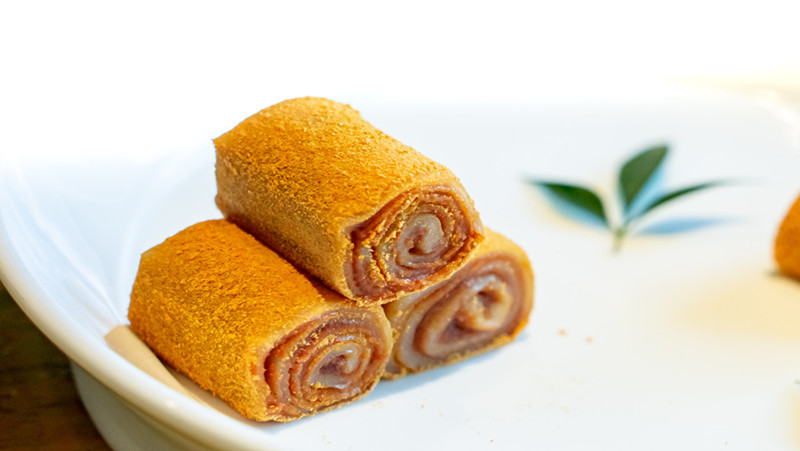Thirteen Traditional Cold Foods in Beijing

Cold Food Festival, also known as No-smoking Festival and Cold Festival, falls on the 105th day after the Winter Solstice, one or two days before the Tomb-Sweeping Day. The main custom of this festival is to ban fire. During this period, it is not allowed to cook with fire, and only cold food is allowed—hence the name. Among them, "Thirteen Cold Foods" best represent Beijing's traditional tastes. Cold Food Festival has lasted for more than 2,000 years and is the only traditional festival of the Han nationality named after eating customs.
Luosizhuan (Spiral Cake) is a traditional Beijing pastry. The outer layer is made of spiral-shaped dough, crisp to the touch. In the old days, snack shops used to dry the leftover Spiral Cakes over a low fire and sell them the next day. The dried Spiral Cake is called "Gan Beng'er (Dry Spiral)." Characteristics: sweet and crisp
Fried Cream Cake is a nutritious snack in Beijing. The cooking method of Fried Cream Cake is a whole art. Sesame oil works the best—other oils aren't as good—and timing is everything. Features: round, crispy on the outside and tender on the inside, rich in flavor, and easy to digest
Hard Pastry is one of the common pastries in Beijing in the past, served at night. Due to the change of lifestyle and the improvement of living standards, the number of street food stalls has decreased, and this snack is no longer available. Characteristics: chewy and sweet
Sesame Paste Cake is one of the special snacks in the north and is very common in Beijing. There are many ways to make Sesame Paste Cakes and many recipes that can be derived from normal pastries. Features: crisp, well-layered, and soft
Saqima, a kind of Manchu food, was one of the three mausoleum offerings outside Shanhai Pass in the Qing Dynasty. Small pieces of fried noodles mixed with sugar are called Saqima. The name originally means "dog's tits dipped in sugar." Characteristics: beige, crisp, soft, and sweet
Ludagun (Donkey Roll) is one of the ancient snacks in Beijing. It's a long roll of yellow rice dough with a filling inside. When eating, the rice roll is rolled on soybean flour, which looks like a donkey rolling, and that's why it's named that way. Characteristics: sweet, soft, unique flavor
Aiwowo (Steamed Rice Cake), a traditional Beijing snack made of glutinous rice, dates back to the Wanli Period of the Ming Dynasty. Steamed Rice Cake can nourish vital energy, the spleen, and the stomach. Characteristics: white, spherical, sticky, and sweet
Tang'erduo (Sugar Ears), one of the most popular snacks in Beijing, are named that way because they are shaped like human ears. They are suitable for autumn, winter, and spring because hot weather in summer tends to melt the syrup. Characteristics: glossy brown, soft and sweet
Tanghuoshao (Baked Sweet Cake) is a breakfast snack commonly eaten in Beijing. It has a history of more than 300 years. It was originally a snack in Hebei province and then introduced to Beijing. It is baked directly on the wall of an urn, hence the name. Characteristics: sweet and crisp
Sliced Ginger Fork is named for its taste of fresh ginger. It is not only a traditional Beijing snack but also a Beijing tea dish, which can fight cancer, diminish inflammation, detoxify, nourish the spleen and stomach and enhance appetite. Characteristics: ginger flavor, crisp and sweet
Sanzi Mahua (Fried Dough Twist) is a popular halal snack in Beijing. It has been one of the must-have foods for the Cold Food Festival since the Qin and Han Dynasties. Characteristics: brownish yellow, super crunchy and sweet, some say "the crispy and crunchy sound can even be heard from miles away."
Jiaoquan (Fried Doughnut) is a local specialty in Beijing. It is bowl-sized and shaped like a western doughnut. It is still crispy and delicious after about half a month in storage. Fried Doughnut is often served with Douzhi (Bean Milk), a local drink in Beijing. Characteristics: dark yellow, unique flavor, and crispy taste
Wandouhuang (Pea-Flour Cake) is a traditional snack in Beijing. It is eaten on lunar March 3rd according to Beijing custom. There are two kinds of it in Beijing: palace and folk. Characteristics: pale yellow, delicate, pure, easy to melt, sweet, cool, and refreshing.
(Source: Bj.wenming.cn)

